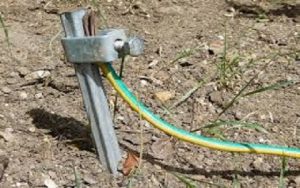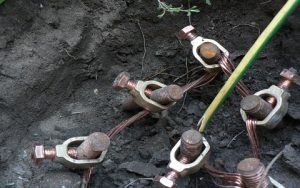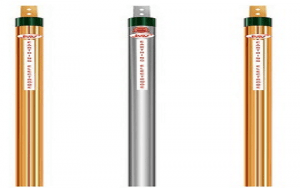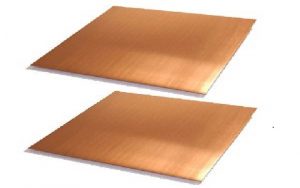Earth is used as an electrical conductor for electricity by man over 270 years back. The other name for Electrical Earthing is Grounding. Electrical earthing is done to protect ourselves from shock during fault conditions. The common electrode used for Earthing is copper, which is used for grounding. The basic requirement of every household or industry is to maintain proper Earthing. The main purpose of the grounding or earthing systems is to provide a reference to the earth. Let us discuss in detail about what is Earthing, why it is required, how Earthing should be done, different types of Earthing and its advantages.
What is Earthing or Grounding?
The safety measures to be taken by connecting any equipment conductive surfaces with Earth Potential is termed as Earthing. Electrical Earthing is shown in the figure.

Earthing
What is Meant by Earthing or Definition of Earthing?
- In an electrical system, the parts of the equipment connected with the Earth’s conductive surface for safety is known as earthing.
Why Earthing is Required?
- During the normal operations rise in potential is one of the main important aspects where the reference to the earth is properly connected. The earthing or grounding provides the very least resistance through which the fault currents are diverted.
- The currents other than the permissible values will be diverted into the ground. The grounding is the difference of the rise in potential between the equipment and the earth.
- The rise in potential can be between the person and the ground or appliance and the earth or appliance to appliance. Proper earthing can limit the differences in potentials between equipment and earth.
- The grounding or earthing limits the voltage rise or potential difference observed on a supply system. In case if there is a lightning strike on the building or on the power distribution towers, the overvoltages which are developed should be safely contacted through the connection to the ground equipment.
- There are some faults occurring normally in power systems like L-G, L-L, L-L-L, and L-L-L-G. Among these L-G and L-L-L-G faults are diverted into the earth. Electrical Earthing provides a protective layer where the fault current is diverted into the earth.
Protective Earthing
- Protection of devices is done by electrical earthing where the visible conductive surface of appliances or devices is made close to the earth’s potential in failure case. Protective earthing is shown in the figure.

Protective Earthing
- In the case of a fault, fault current flows from the equipment to earth to protect against electric shock. The protective devices like fuses, circuit breakers detect the fault and interrupts the supply during fault conditions.
- Though these protective devices isolate the circuit their operating level is too high. So, the Impedance of connection to earth is kept low compared to the normal circuit to divert fault current to earth.
Types of Earthing?
There are different types of earthing system mostly used. They are
- Plate earthing
- Pipe earthing
- Rod earthing
Plate Earthing
- The plate material is of either copper or galvanized iron is used in the plate earthing system. This plate selected should of certain specified dimensions, which is placed inside the earth at a depth less than 3 meters from the bottom. This plate is connected to the electrical conductors to divert the electric charge inside the earth. The diagram of Plate Earthing is given below.

Earthing plate
Pipe Earthing
- A galvanized iron pipe is selected should be such that it has holes pierced at regular intervals and the pipe is narrow at the bottom end.
- A clamp is attached to the G.I pipe to which an earth wire is connected. This pipe diverts the electrical conductance inside the earth. Pipe Earthing is shown in the figure.

earthing pipe
- The pipe is placed in the earth pit at a depth not less than 3 meters. The space inside the G.I pipe is filled by the alternate layers of salt and charcoal up to the clamp level.
- The top portion of the G.I pipe is left open for maintenance when required by constructing a chamber with bricks. Water is poured into the G.I pipe to maintain earthing resistance within the specified limits.
- A galvanized steel and a pipe that has holes at regular intervals are kept inside the earth. Keeping in view its low-cost Pipe earthing is commonly used for all domestic purposes.
Rod earthing
This type of earthing is similar to pipe earthing, but a rod made of galvanized steel is used in this case. The rod used for this purpose is buried inside the earth at a certain depth. As it is of low resistive material, the short circuit current will be diverted to the ground safely. The rod earthing diagram is given the following figure.

Earthing rod
Difference Between Pipe and Plate Earthing
The basic difference between pipe and plate earthing is
- In plate earthing, the plate is connected to the electrical conductors to discharge to the earth whereas, in Pipe earthing, the Galvanised Iron pipe is connected to electrical conductors to discharge to the earth.
Advantages of Pipe Earthing over Plate Earthing
- In plate earthing, we use copper which is of the high cost. So, the Galvanised Iron pipe which is of less cost is preferred than plate earthing.
- It requires less maintenance.
Applications of Electrical Earthing at Low Voltage Systems
- The low voltage system consumption appliances are available at the domestic users where proper electrical earthing is done to protect the electrical appliances and also protect ourselves against electric shocks.
- For domestic users, the common fault that occurs is due to voltage fluctuations. During voltage fluctuations proper electrical earthing plays a key role.
- In high voltage system (>1kv) the focus of the earthing system is less on safety but it is more important to look after the reliability of power supply, protection of equipment. The most common type of fault is the L-G fault in the high voltage system. During the L-G fault, the fault current path is closed through the earth.
Please refer to this link to know more about Electrical Distribution System MCQs, Electric Illumination MCQs, Transmission Line MCQs.
Therefore, this is all about what is Earthing? It is basically done to protect ourselves from electric shocks. This article discusses an overview of the safety measures to be taken by connecting any equipment conductive surfaces to the Earth which is termed as Earthing. And also we have discussed why earthing is required, protective earthing, different types of earthing and the difference between them, and applications. Here is a question for you, what is the function of the pin-3 in a plug?

